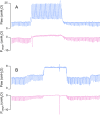Laryngeal closure impedes non-invasive ventilation at birth
- PMID: 29054974
- PMCID: PMC5868244
- DOI: 10.1136/archdischild-2017-312681
Laryngeal closure impedes non-invasive ventilation at birth
Abstract
Background: Non-invasive ventilation is sometimes unable to provide the respiratory needs of very premature infants in the delivery room. While airway obstruction is thought to be the main problem, the site of obstruction is unknown. We investigated whether closure of the larynx and epiglottis is a major site of airway obstruction.
Methods: We used phase contrast X-ray imaging to visualise laryngeal function in spontaneously breathing premature rabbits immediately after birth and at approximately 1 hour after birth. Non-invasive respiratory support was applied via a facemask and images were analysed to determine the percentage of the time the glottis and the epiglottis were open.
Hypothesis: Immediately after birth, the larynx is predominantly closed, only opening briefly during a breath, making non-invasive intermittent positive pressure ventilation (iPPV) ineffective, whereas after lung aeration, the larynx is predominantly open allowing non-invasive iPPV to ventilate the lung.
Results: The larynx and epiglottis were predominantly closed (open 25.5%±1.1% and 17.1%±1.6% of the time, respectively) in pups with unaerated lungs and unstable breathing patterns immediately after birth. In contrast, the larynx and the epiglottis were mostly open (90.5%±1.9% and 72.3%±2.3% of the time, respectively) in pups with aerated lungs and stable breathing patterns irrespective of time after birth.
Conclusion: Laryngeal closure impedes non-invasive iPPV at birth and may reduce the effectiveness of non-invasive respiratory support in premature infants immediately after birth.
Keywords: Non-invasive ventilation; apnoea; glottis; larynx; preterm newborn.
© Article author(s) (or their employer(s) unless otherwise stated in the text of the article) 2018. All rights reserved. No commercial use is permitted unless otherwise expressly granted.
Conflict of interest statement
Competing interests: None declared.
Figures






References
MeSH terms
Grants and funding
LinkOut - more resources
Full Text Sources
Other Literature Sources
Medical
